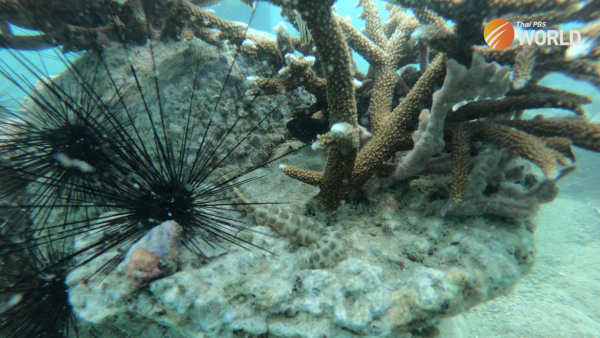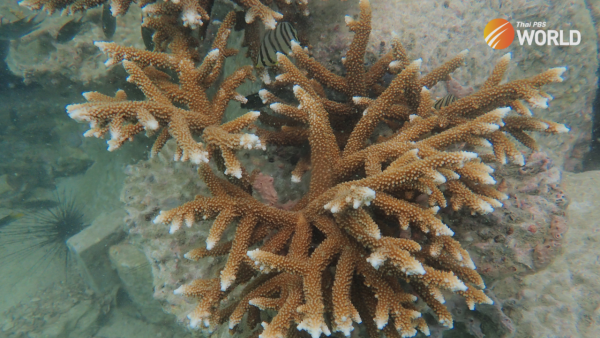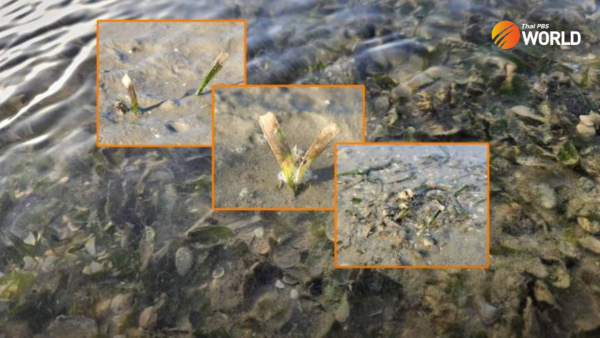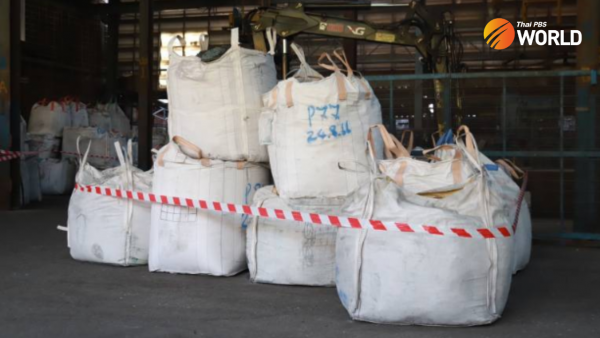Innovative technology can help protect coral reefs and you can too

The brightly colored coral reefs teeming with marine life are far more than just a magnificent sight. The natural undersea attractions that beckon snorkelers and divers also create recreational and job opportunities, generating income for local communities and businesses. More importantly, coral reefs provide a habitat for a diversity of marine creatures and buffer the shores from waves that may flood coastal communities, thus helping prevent loss of life and property.
In spite of their importance, coral reefs in the Thai seas and the world’s oceans are facing a plethora of threats including overfishing, physical damage from coastal development, pollution, removal for sale, and unsustainable tourism. Warming waters caused by climate change are causing coral bleaching. These threats have affected and continue to affect the health of the oceans and the ecosystems that support ocean life.
A 2018 survey on the status of coral reefs in Thailand by the Department of Marine and Coastal Resources (DMCR) showed that about 37% are damaged or severely damaged, 31.6% are in fairly healthy condition and the rest (31.4%) are in good or very good condition.
In an attempt to restore the damage, the Thai government, institutions, organizations, and the private sector have put their heads together and rolled out coral reef restoration projects using different methods from artificial coral reefs to coral gardening and transplanting.
“Saving coral reefs means helping the rest of our marine life,” said Assoc Prof Dr Nantarika Chansue, president of Earth Agenda Foundation and director of the Veterinary Medical Aquatic Animal Research Center of Excellence, Chulalongkorn University’s Faculty of Veterinary Science.

3D printing of artificial coral reefs
Rather than using steel or concrete which are popular substrates for artificial coral reefs, Earth Agenda Foundation has used cement-based materials and 3D printing to develop modular structures, which are intended to provide a base for coral larvae to settle and grow and serve as shelter for marine creatures.
“With the help of 3D printing technology, we can design and create artificial coral reefs with complex structures quite similar to those found in nature. The shape of the structures helps corals to attach themselves easily and can attract marine life to make their homes on the reefs,” she said, adding that coral larvae need a suitable structure on which to settle before they start growing and thriving.
The effort is part of “Love the Sea” project managed by the foundation, with the aim of facilitating the restoration of coral reefs and marine ecosystems. The project was created through a collaboration between teams at Chulalongkorn University’s Faculty of Veterinary Science and DMCR under the Ministry of Natural Resources and Environment and SCG.
Nantarika said the teams call this 3D printed artificial coral reef “Innovareef”.
Artificial coral reefs are one of several tools used in coral reef restoration. They are made of a wide range of materials that can serve as substrates to provide a place for corals and create a home for marine life. In the old days, materials of opportunity and by-products like shipwrecks, train cars, and decommissioned military ships were submerged in the waters to form a new reef. These days, other alternative materials such as steel structures, concrete, old tyres, PVC pipes and high voltage transmission line insulators are also sunk to attract marine creatures.
However, studies have found that some of the materials leach toxic chemicals that have adverse effects on the environment after being dumped onto the sea floor. Many have proved unstable, moving all over the seabed and being swept back to shore during storms. Others simply didn’t resemble a natural reef because of their smooth surface, making it difficult for organisms and corals to latch onto. They eventually ended up as ocean trash, marring the appeal of the underwater world.
Innovareef is made of cement-based materials, molded using a 3D printer that makes it strong and durable so that it doesn’t sink into the sand and is resistant to tidal forces. This modular artificial coral reef structure is fitted with rocky surface and then coated with coral nutrients in an effort to improve coral settlement efficiency. In addition, it has holes and cavities where small fish can nest and hide from predators.
“The cement-based materials we use are natural and friendly to the environment. What’s more, some corals prefer rough textured substrates,” the marine scientist said.
When it comes to installation, Nantarika explained that divers take units of the artificial coral reel structure underwater and assemble them like Lego bricks. Once placed on the sea floor, they also attach naturally broken fragments of coral that are still alive to the 3D reef in an effort to foster growth on the structure.

A promising restoration method
Since 2020, the 3D printed artificial coral reefs have been placed along the Gulf of Thailand near the islands of Koh Larn, Koh Sichang and Koh Samae San off the Chonburi coast.
Following the placement, a team of researchers and marine scientists at the Veterinary Medical Aquatic Animal Research Center of Excellence conducted experiments with these man-made structures to track the ways in which they are beneficial to marine creatures and the extent to which they were inhabiting the reefs.
The research showed that rates of coral settlement on the 3D artificial coral reefs were about 2-3 times faster than conventional coral reefs. The coral fragments transplanted to the reefs were also found to grow faster. And they have been well accepted by aquatic animals.
“Just one month after the reef was placed underwater, it began attracting curious sea life. We saw species taking shelter on it. Clownfish and a giant clam appeared to prefer the reef, swimming near it. Sponges and anemones, corals and other organisms also began to grow on it, forming a community,” Nantarika said.
She added that the team is also studying the potential of nano-technology in saving coral reefs and the possibility of protecting corals from heat stress and coral bleaching.
Small efforts make a big difference
Coral reef restoration is a complicated task that requires the collaboration and efforts of all parties including the government, the private sector, businesses, the local community and the public at large, Nantarika noted.
“Coral reef restoration projects are part of saving our underwater ecosystems. They are a useful tool in helping coral reefs recover,” she said, adding that policy, plans, funding and contributions are also needed if restoration and protection are to be successful.
The DMCR’s deputy chief Pornsri Suthanaruk said the department hopes to increase healthy coral reefs coverage to at least 40% by 2022. It also aims to expand its marine protected area coverage to 1,000 square kilometers each year and continue working with organizations, foundations and clubs to monitor life in the sea, conduct research and educate the public about the coastal and marine environment. This is in line with the 20-year Strategic Plan of the Ministry of Natural Resources and Environment (2017-2036).
To help save the oceans and the ecosystems, Nantarika urged people to use less water, as water contamination is one of the main contributors to the degeneration of coral reefs.
“Using less water means less runoff and wastewater that contain chemicals and other substances that hurt the oceans and the reefs,” she said.
She also called on tour operators to become more sustainable to minimize their environmental impacts and encouraged tourists to support eco-conscious operators and be respectful when visiting a coral reef.
“Travellers should always stick to the reef rules and follow local guidelines on how to interact with them. They should also learn how to protect them. When you touch the reefs or break parts of them, corals become stressed,” she said.
The marine conservationist also urged travelers to dispose of their trash properly and pick up the rubbish others have left behind in the town and on the beach.
“Picking up a piece of trash can save a life. Even a little effort can make a difference,” she said.






